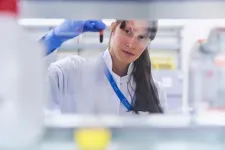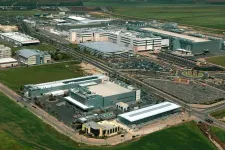(Press-News.org) Named after the two-faced Roman god Janus to reflect its dual-purpose design, researchers present a novel membrane system – a Janus channel of membranes (JCM) – capable of simultaneously separating oil and water from complex emulsions. The system addresses a critical challenge for sustainable water and oil reclamation across various industries. Separating oil and water from complex mixtures is essential for many scientific and industrial applications, such as wastewater treatment and biological sorting. Membrane technologies play a critical role in these processes. However, traditional membranes often remove only one component at a time, complicating further separation efforts and creating disposal challenges. This limitation is especially significant in treatment of oily wastewater, a common byproduct of both daily life and industrial activities – and widely recognized as one of the most serious threats to ecosystems and water sources. Although several treatment methods have advanced remediation and oil recovery from water, current membrane technology struggles to recover oil and water simultaneously from surfactant-stabilized emulsions.
Xin-Yu Guo and colleagues introduce a Janus channel of membranes system featuring a novel design that consists of a narrow, confined channel flanked by contrasting hydrophilic and hydrophobic membranes. As the emulsion mixture flows through this channel, pressure drives water molecules toward the hydrophilic membrane, allowing water to pass through while concentrating oil within the channel. The increase in oil density triggers hydrodynamic forces that encourage oil droplets to collide and merge, forming larger droplets with reduced surface energy, which can then pass through the hydrophobic membrane. This continuous process creates a feedback loop of enrichment, coalescence, and demulsification, allowing for the simultaneous, high-purity separation of oil and water without the concentration issues seen in traditional systems. In tests, Guo et al. show that the JCM system achieves impressive separation performance, with oil recovery of around 71% and water recovery of roughly 94% – both exceeding 99% purity. What’s more, unlike traditional hydrophilic membranes, which are limited to emulsions with less than 10% oil content, the JCM can process oil-in-water emulsions with oil content as high as 40%, still reaching over 50% water recovery and over 80% oil recovery. “The concept of Guo et al. goes beyond a simple oil-and-water separation from a complex mixture and can be applied to other types of challenging separations in large-scale industries,” write Xing Yang and Mohammad Hossein Jandaghian in a related Perspective. “Separation of water or glycerol from biofuels, valuable metals from mine tailings, and proteins and vitamins from dairy products are just a few examples.”
END
Presenting a Janus channel of membranes for complete oil-and-water separation
Summary author: Walter Beckwith
2024-11-07
ELSE PRESS RELEASES FROM THIS DATE:
COVID-19 restrictions altered global dispersal of influenza viruses
2024-11-07
Although travel restrictions and social measures during the COVID-19 pandemic led to a dramatic global drop in seasonal influenza cases, certain influenza lineages in specific regions kept the virus circulating and evolving, according to a new study. This was true in tropical areas with fewer travel restrictions, for example, including South and West Asia. The spread of seasonal influenza is closely tied to social behavior, particularly air travel, and to the periodic evolution of new virus strains that evade immunity from prior infections or vaccinations. In 2020, nonpharmaceutical interventions (NPIs) introduced to combat COVID-19 – such as ...
Disconnecting hepatic vagus nerve restores balance to liver and brain circadian clocks, reducing overeating in mice
2024-11-07
Disruptions between the brain’s master circadian clock and the liver’s internal clock, communicated via the hepatic afferent vagal nerve (HVAN), can lead to unhealthy eating patterns and increased weight gain, according to a new study in mice. The findings identify the neural link as a potential therapeutic target for obesity and metabolic dysfunction related to circadian disruption. In mammals, circadian rhythms are controlled by the suprachiasmatic nucleus (SCN) – a small part of the brain’s hypothalamus that regulates the body’s circadian rhythms. This cycle triggers a feedback loop involving key clock genes that keep ...
Mechanosensory origins of “wet dog shakes” – a tactic used by many hairy mammals – uncovered in mice
2024-11-07
“Wet dog shakes” – a common reflex behavior shared among many hairy mammals and designed to expel water and irritants from their coats – happens when particular mechanoreceptors are activated, researchers studying mice report. Many furry mammals engage in rapid body twists known as "wet dog shakes" to effectively remove water from their fur, as well as to eliminate irritants like tangles or parasites, particularly in areas on the neck and back that are largely unreachable by self-grooming or licking. However, despite the commonality of this behavior ...
New study links liver-brain communication to daily eating patterns
2024-11-07
PHILADELPHIA— People who work the nightshift or odd hours and eat at irregular times are more prone to weight gain and diabetes, likely due to eating patterns not timed with natural daylight and when people typically eat. But is it possible to stave off the ill effects of eating at these “unusual” times despite it not being biologically preferable? A new study from the Perelman School of Medicine at the University of Pennsylvania says ‘yes’, and sheds light on how the body knows when to eat. The study, published today in Science, explains how researchers discovered a connection between the liver's internal clock and feeding centers in the ...
Defense or growth – How plants allocate resources
2024-11-07
The more a plant species invests in defense, the less potential it has for growth, according to a new study. Research made possible by open science provides new insights into plant adaptation and interspecies variation.
Pathogens can significantly weaken the fitness of their hosts, sometimes even causing host mortality. Yet considerable variation is found between species in their investment in disease defense. Evolutionary theory predicts that allocation costs regulate this investment, but testing this hypothesis ...
Study identifies hip implant materials with the lowest risk of needing revision
2024-11-07
Hip implants with a delta ceramic or oxidised zirconium head and highly crosslinked polyethylene liner or cup had the lowest risk of revision during the 15 years after surgery, a new study led by the University of Bristol has found. The research could help hospitals, surgeons and patients to choose what hip implant to use for replacement surgery.
The aim of the study was to establish hip implant materials at risk of revision to help orthopaedic surgeons, and patients, and to improve shared decision making ...
Study reveals how plants grow thicker, not just taller
2024-11-07
Most research on plant stem cells focuses on the tips of roots and shoots, where growth occurs in height. But Ten Tusscher explains that thickness growth is just as essential. “Plants can’t grow endlessly in height. They also need to grow in thickness, or they would simply fall over,” she says. The growth in thickness, is what makes older trees visibly thicker and more robust over time. This growth is essential for structural strength, particularly in trees.
Stem cells in the plant’s cambium layer control this width growth, producing wood to support the plant’s structure. However, which genes enable these cambium stem cells to become active ...
Insect-killing fungi find unexpected harmony in war
2024-11-07
University of Maryland entomologists uncovered a unique relationship between two species of fungi known for their ability to invade, parasitize and kill insects efficiently. Instead of violently competing for the spoils of war, the two fungi peacefully cooperate and share their victims.
The findings, published in the journal Public Library of Science (PLOS) Pathogens on November 7, 2024, offer insight into some of the biggest evolutionary successes in nature’s history, according to study co-authors Raymond St. Leger, a Distinguished University Professor of Entomology, and entomology Ph.D. candidate Huiyu Sheng.
“It’s not survival ...
Unlocking predictors of success in treating inflammatory bowel disease (IBD)
2024-11-07
Not everyone responds equally well to treatments for inflammatory bowel disease (IBD). What will work for individual patients involves trial and error during the treatment process. Now, a team of researchers led by Charité – Universitätsmedizin, in collaboration with colleagues in Berlin and Bonn, has succeeded in identifying a biomarker that indicates whether or not treatment with a certain medication called an immunomodulator will be successful. Writing in the journal Gastroenterology,* the researchers note that this will permit more targeted use of the therapy.
Inflammatory bowel disease (IBD) takes multiple ...
New PFAS removal process aims to stamp out pollution ahead of semiconductor industry growth
2024-11-07
CHAMPAIGN, Ill. — A University of Illinois Urbana-Champaign study is the first to describe an electrochemical strategy to capture, concentrate and destroy mixtures of diverse chemicals known as PFAS — including the increasingly prevalent ultra-short-chain PFAS — from water in a single process. This new development is poised to address the growing industrial problem of contamination with per- and polyfluoroalkyl substances, particularly in semiconductor manufacturing.
A previous U. of I. study showed that short- and long-chain PFAS can be removed from water using electrochemically driven adsorption, referred to as ...
LAST 30 PRESS RELEASES:
Artificial saliva containing sugarcane protein helps protect the teeth of patients with head and neck cancer
Understanding the role of linear ubiquitination in T-tubule biogenesis
Researchers identify urban atmosphere as primary reservoir of microplastics
World’s oldest arrow poison – 60,000-year-old traces reveal early advanced hunting techniques
Bristol scientists discover early sponges were soft
New study uncovers how rice viruses manipulate plant defenses to protect insect vectors
NSF–DOE Vera C. Rubin Observatory spots record-breaking asteroid in pre-survey observations
Ribosomal engineering creates “super-probiotic” bacteria
This self-powered eye tracker harnesses energy from blinking and is as comfortable as everyday glasses
Adverse prenatal exposures linked to higher rates of mental health issues, brain changes in adolescents
Restoring mitochondria shows promise for treating chronic nerve pain
Nature study identifies a molecular switch that controls transitions between single-celled and multicellular forms
USU chemists' CRISPR discovery could lead to single diagnostic test for COVID, flu, RSV
Early hominins from Morocco reveal an African lineage near the root of Homo sapiens
Small chimps, big risks: What chimps show us about our own behavior
We finally know how the most common types of planets are created
Thirty-year risk of cardiovascular disease among healthy women according to clinical thresholds of lipoprotein(a)
Yoga for opioid withdrawal and autonomic regulation
Gene therapy ‘switch’ may offer non-addictive pain relief
Study shows your genes determine how fast your DNA mutates with age
Common brain parasite can infect your immune cells. Here's why that's probably OK
International experts connect infections and aging through cellular senescence
An AI–DFT integrated framework accelerates materials discovery and design
Twist to reshape, shift to transform: Bilayer structure enables multifunctional imaging
CUNY Graduate Center and its academic partners awarded more than $1M by Google.org to advance statewide AI education through the Empire AI consortium
Mount Sinai Health system receives $8.5 million NIH grant renewal to advance research on long-term outcomes in children with congenital heart disease
Researchers develop treatment for advanced prostate cancer that could eliminate severe side effects
Keck Medicine of USC names Christian Pass chief financial officer
Inflatable fabric robotic arm picks apples
MD Anderson and SOPHiA GENETICS announce strategic collaboration to accelerate AI-driven precision oncology
[Press-News.org] Presenting a Janus channel of membranes for complete oil-and-water separationSummary author: Walter Beckwith



